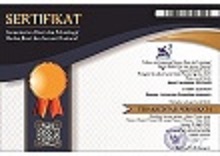The Role of Sustainable Architecture on Environmental Ethics in Islamic View, Case Study: Nagara Rimba Nusa and Putra Jaya
Abstract
The revolution in the field of architecture has brought rapid development but also caused negative impacts on the environment, this research discusses the role of sustainable architecture in the context of environmental ethics, focusing on the Islamic perspective, sustainable architecture based on the principles of Islamic views can be a solution to reduce the negative impact of architecture on the environment. This paper uses a case study method and collects literature studies with the direction of combining the 5 principles of sustainable perspectives according to Islam in the literature of Islam and sustainable development with environmental ethics elaborated into the basis of the direction of the role of sustainable architecture towards the environment in Islamic views, the aim is to describe the literature that discusses Nagara Rimba Nusa and Putra Jaya then what are the principle values applied in the concepts of Nagara Rimba Nusa and Putra Jaya to find the role of sustainable architecture between the two guided by the principle values of the Islamic perspective in order to answer the problems that arise related to the environment. The conclusion in this paper is that the role of sustainable architecture in Nagara Rimba Nusa is an example of a sustainable architecture concept that is applied to a design and can reduce the impact on the environment if it is based on environmental ethics by being guided by Islamic views on the 5 principles of sustainable perspectives according to Islam in the literature of Islam and sustainable development. Nagara Rimba Nusa has implemented several principles because it is still in the process of implementation in contrast to Putra Jaya which has fulfilled the 5 principles of sustainability in Islam because it has been implemented and has good results on the environment from the perspective of Islamic values.
Full Text:
PDFReferences
Keraf. (2006). Etika Lingkungan Hidup.Kompas. Jakarta.
Annisa, Siti arfah., (2004), Konsep Arsitektur Berkelanjutan
Hardjasoemantri, Koesnadi (1994). Hukum Tata Lingkungan. Yogyakarta. Gadjahmada University Press.
Sibrani, (2022). Pemenang syembara desain Ibu Kota Nusantara. Helmi yahya bicara
Supriyatna (2018). Rekayasa arsitektur Berkelanjutan Berdasarkan Nilai-nilai KeIslaman. Universitas Muhammadiyah Jakarta
Jacobs (1961). The death and life of great American cities, Rebecca Solnit
-126756-2-PB. (n.d.).
Aguspriyanti, C. D. (2021). Green Corridors: Potensi Peningkatan Ruang Terbuka Hijau Publik Ramah di Kota Padat (Studi Kasus Kota Malang). Jurnal Arsitektur ZONASI, 4(2), 234–345. https://doi.org/10.17509/jaz.v4i2.33439
Al-Jayyousi, O. R. (2012). Islam and Sustainable Development. Gower Publishing Limited.
Almagfira, A., Cherlyta Apriliani Nasution, A., Nur Fatimah, G., Nikita Wahdah, A., Charisma Putra Ramadhon, D., Rizki Alvito, H., Insani Kamil, S., & Catherine Carina Tambunan, J. (n.d.). Media Hukum Indonesia (MHI) Partisipasi Masyarakat Dalam Penerapan Konsep Sustainable Development Terhadap Pembangunan Ibu Kota Negara Nusantara. 2(2), 462. https://doi.org/10.5281/zenodo.11905462
Aristawati, Y., Budiman, H., Agustiananda, P. A. P., & Ramli, N. I. (2023). Recycling in Islamic Perspective Case Study of Architectural Works Using Waste Building Materials. International Journal of Engineering, 5(2). https://journal.uty.ac.id/index.php/IJETS/article/view/271/167
Aureline Marsha Buwono, R., & Sigit Arifin, L. (2023). Studi Nilai Keberlanjutan Elemen Struktur Rumah Tradisional Nias. In ACESA (Vol. 5, Issue 2).
Baiquni, M. (2009). REVOLUSI INDUSTRI, LEDAKAN PENDUDUK DAN MASALAH LINGKUNGAN. Jurnal Sains Dan Teknologi Lingkungan, 1(1).
Citra Nurkamilah. (2018). ETIKA LINGKUNGAN DAN IMPLEMENTASINYA DALAM PEMELIHARAAN LINGKUNGAN ALAM PADA MASYARAKAT KAMPUNG NAGA.
Febrisky, A. I., & Rochana, I. P. (2024). IDENTIFIKASI PENERAPAN ARSITEKTUR BERKELANJUTAN PADA KANTOR GERBANG TOL KARTASURA. http://siar.ums.ac.id/
Foltz, R. C., Denny, F. M. B., & Baharuddin, A. (2003). Islam and Ecology (2003). Harvard University Press.
Gindo Leontinus R. Siringoringo. (2022). PROGRAM DALAM PELAKSANAAN TUJUAN PEMBANGUNAN BERKELANJUTAN (SDGs) DALAM HAL MASALAH PERUBAHAN IKLIM DI INDONESIA.
Nashrullah Amin, M., Winarto, Y., & Marlina, A. (2019). PENERAPAN PRINSIP ARSITEKTUR BERKELANJUTAN PADA PERENCANAAN KAMPUNG PANGAN LESTARI DI MOJOSONGO, KECAMATAN JEBRES, KOTA SURAKARTA.
Nasution, F. A., Aldy, P., & Susilawaty, M. D. (2020). KAJIAN ARSITEKTUR BIOMIMIKRI DALAM PERANCANGAN ROKAN HULU BUTTERFLY PARK AND CONSERVATION CENTER. Jurnal Arsitektur ZONASI, 3(3), 322–337. https://doi.org/10.17509/jaz.v3i3.26876
Ningrum, S. H., Noviansyah, R., & Dewi, A. K. (2025). EKOTEOLOGI DAN SUSTAINABLE ENVIRONMENT: STUDI PERAN RUMAH IBADAH TERHADAP KONSERVASI HUTAN TROPIS INDONESIA. In Terra: Journal of Forest Management Original Paper (Vol. 1, Issue 1).
Prabowo, A., Al-Ghifari, M. A. A., Fadlilah, F. N., Pakuan, G. M., & Zulfahmi, M. H. (2019). IDENTIFIKASI MATERIAL BERKELANJUTAN PADA RUANG LUAR DAN RUANG DALAM BANGUNAN KANTOR. Jurnal Arsitektur ZONASI, 2(3), 160. https://doi.org/10.17509/jaz.v2i3.19492
Purwaningsih Sintya. (2024). Revolusi+Material+dalam+Arsitektur+Penemuan+dan+Penerapan+Material+Baru. Vol. 1 No 3 2024.
Putra, R. (2018). PERAN TEKNOLOGI DIGITAL DALAM PERKEMBANGAN DUNIA PERANCANGAN ARSITEKTUR RIZA AULIA PUTRA. In Elkawnie: Journal of Islamic Science and Technology (Vol. 4, Issue 1). www.jurnal.ar-raniry.com/index.php/elkawnie
Studi Arsitektur, P., & Arsitektur dan Perencanaan, J. (2022). Sarvina Fitri Rizky. Keberlanjutan Arsitektur Tradisional Aceh Pada Perkembangan Rumah Tinggal, 5. https://doi.org/10.17509/jaz.v5i1.41398
Sumarno, O. (n.d.). PEMBELAJARAN DARI MALAYSIA DALAM PEMINDAHAN IBU KOTA NEGARA. https://nasional.kompas.com/read/2019/08/27/09284821/4-alasan-mengapa-ibu-kota-indonesia-harus-keluar-
Supriyatna (2018). Rekayasa arsitektur Berkelanjutan Berdasarkan Nilai-nilai KeIslaman. Universitas Muhammadiyah Jakarta
DOI: https://doi.org/10.17509/jaz.v8i2.73390
Refbacks
- There are currently no refbacks.
Copyright (c) 2025 agil satrio pambudi, pram anda fataros, hanif budi man, putu ayu pramanasari agustinanda

This work is licensed under a Creative Commons Attribution-ShareAlike 4.0 International License.





